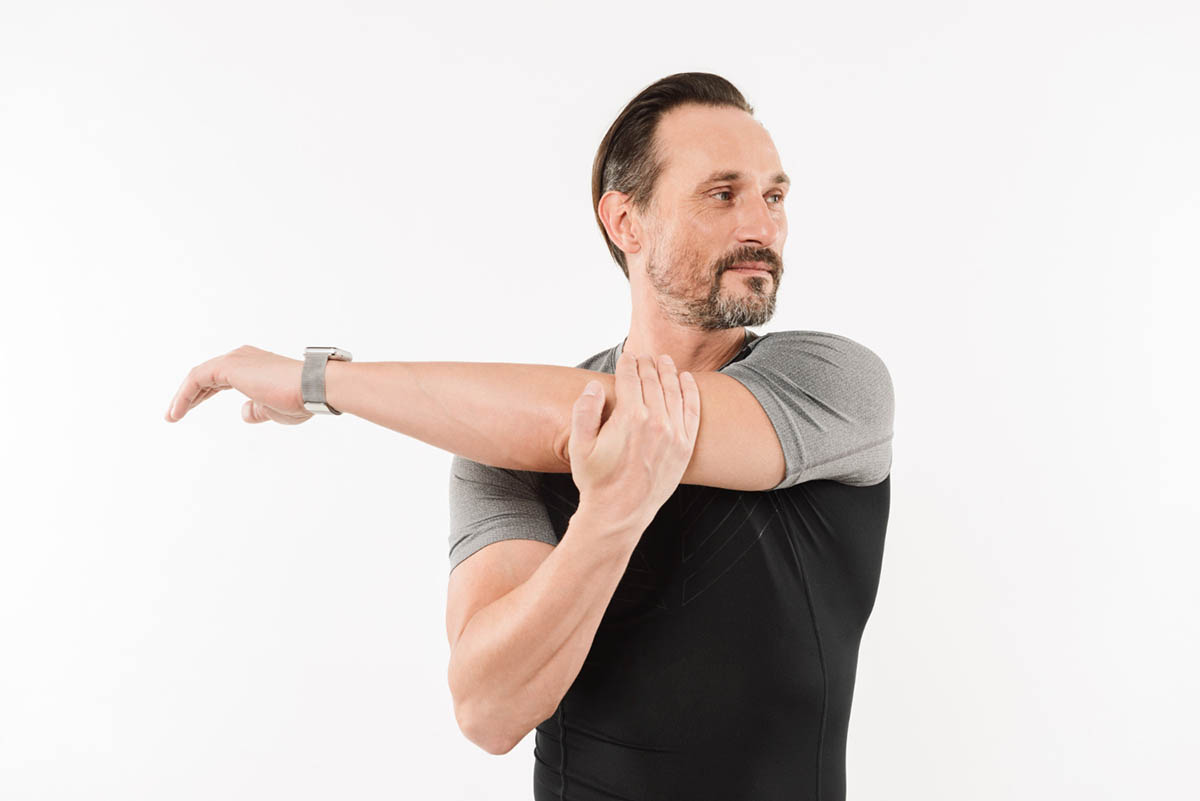Introduction
In our relentless pursuit of a pain-free life, pain in between or around the shoulder blade emerges as a formidable obstacle, impeding our ability to perform everyday activities and diminishing our overall quality of life. Whether stemming from poor posture, strenuous overhead movements, or underlying medical conditions, the discomfort it causes is not to be underestimated. This blog aims to shed light on the details of this pain and explore exercises designed for shoulder blade pain relief, thereby paving the way for enhanced shoulder mobility, stability, and well-being.
Understanding Shoulder Blade Pain
Anatomy of the Shoulder Blade Muscles
The shoulder blade, or scapula, is a triangular bone that plays a crucial role in the functionality of the upper body, facilitating a wide range of arm movements. The muscles surrounding the scapula—including the rotator cuff, which is prone to tears; the trapezius; rhomboids; and deltoids—work in unison to support these movements.
Often described as interscapular pain or pain in the shoulder blades, the conditions causing shoulder pain can arise from various conditions, including myofascial pain syndrome, musculoskeletal dysfunctions, arthritis, or even referred pain from heart conditions like a heart attack, where chest pain and shortness of breath are prominent symptoms.
Understanding the intricate mechanics of these muscles is essential for effectively targeting shoulder blade pain. Exercises tailored to strengthen and stretch these muscles can mitigate the discomfort, improve mobility, and forestall future injuries.
Benefits of Exercise for Shoulder Blade Pain Relief
Shoulder blade pain relief exercises serve as a cornerstone for managing pain, offering benefits that include:
- Increased Blood Circulation and Oxygen Flow: Enhancing blood flow to the shoulder area aids in healing and reduces inflammation, potentially easing symptoms like sharp pain and muscle weakness.
- Strengthening of Shoulder Blade Muscles: Fortifying these muscles ensures balanced support for the shoulder joint, alleviating the burden on any single group and preventing the type of pain that can disrupt daily activities.
- Improved Posture and Alignment: Correcting tilted posture through targeted exercises can significantly reduce the risk of pain, particularly pain originating from muscular imbalances or the strain of routine activities.
- Enhanced Flexibility and Range of Motion: Maintaining flexibility through regular exercise therapy prevents the stiffness and tight muscles that can limit movement and cause pain.
- Reduction of Muscle Tension and Knots: Engaging in stretching and massage therapy helps to release tension in the shoulder muscles, providing relief from severe pain and improving the range of motion.
- Promotion of Joint Stability: Strong muscles around the scapula support the shoulder joint, safeguarding against dislocations and reducing the likelihood of experiencing sudden difficulty in movement.
- Prevention of Future Shoulder Blade Pain: Through strengthening core muscles and improving flexibility, exercise acts as a preventive measure against recurring pain.
- Boosted Overall Well-being and Quality of Life: Engaging in a regular workout routine enhances mental health, mitigating stress and promoting a sense of well-being that is crucial for managing pain.
- Complementary Approach to Pain Management: Incorporating exercises into a broader pain management strategy, which may include pain relief medications, heat therapy, or even a corticosteroid injection, offers a holistic approach to relief.
- Positive Impact on Mental Health and Stress Reduction: The psychological benefits of regular physical activity, including the reduction of excessive sweating and the prevention of stress-related symptoms like acid reflux, contribute significantly to the management of shoulder blade pain.
How Regular Exercise Improves Shoulder Mobility

Engaging in a consistent exercise regimen is pivotal for enhancing shoulder mobility. Targeted exercises ensure that the shoulder remains flexible and capable of performing a wide array of movements, crucial for carrying out regular activities without discomfort.
This mobility is facilitated by the lubrication of joints through the production of synovial fluid and the prevention of muscle shortening and tightening, which can lead to severe pain and limited movement. Exercise and movement can also help restrictions in the fascia that surrounds the muscles of the shoulder, and help them glide over one another with more ease and less restriction. Over time, exercise can significantly improve the range of motion, reduce discomfort, and foster the health of the shoulder joint, contributing to a lifestyle unencumbered by pain.
Strengthening Exercises for Shoulder Blade Muscles
For those grappling with shoulder blade pain, integrating the following strengthening exercises into one’s routine can offer substantial benefits:
Push-Ups
Beyond their role in building chest and arm strength, push-ups help stabilize the scapula, contributing to shoulder blade health and preventing the kind of severe pain that interrupts everyday activities.
Bent-Over Rows
This exercise targets the muscles in the shoulder blade region, particularly beneficial for those with muscle weakness, ensuring the maintenance of a strong and balanced upper back.
Reverse Flys
Performing reverse flys with dumbbells or a resistance band strengthens the posterior deltoids and rhomboids, which are pivotal for the stability and function of the shoulder blades.
Shoulder Blade Squeezes
Focused on the rhomboids and trapezius muscles, shoulder blade squeezes are essential for correcting posture, and mitigating the risk of pain associated with prolonged sitting or standing.
Lat Pulldowns
Targeting the latissimus dorsi, these pulldowns are crucial for widening and strengthening the back, providing robust support for the scapulae and mitigating pain signals that can disrupt a pain-free existence.
Resistance Band Pull-Aparts
A simple yet effective exercise, resistance band pull-aparts work the shoulder’s posterior muscles, aiding in the reduction of muscle tension and the improvement of posture, crucial for a lifestyle free from the constraints of pain.
Dumbbell Shoulder Press
Engaging the deltoids and trapezius, the dumbbell shoulder press supports overall shoulder health. This exercise is particularly beneficial for combating the muscle weakness that can exacerbate shoulder blade pain.
YTWL Exercise
Named for the letter shapes you mimic with your arms, the YTWL exercise targets a variety of shoulder and upper back muscles, promoting flexibility and reducing the risk of tight muscles and subsequent pain.
Superman Exercise
By simulating the flying position of Superman, this exercise strengthens the back extensors and shoulder muscles, which are vital for maintaining proper posture and shoulder alignment, thus avoiding pain in the shoulder blades.
Stretching Exercises for Shoulder Blade Pain Relief

To complement strengthening exercises, incorporating stretching into your routine is vital for pain management and prevention:
Shoulder Rolls
Performing shoulder rolls in a circular motion helps release tension in the neck and shoulder area, fostering relaxation and reducing the likelihood of experiencing sharp pain.
Neck and Shoulder Stretch
This stretch is designed to alleviate tightness in the neck and shoulders, areas often implicated in shoulder blade pain, especially pain that might be mistaken for conditions like acid reflux or heart attack due to its intensity and location.
Cross-Arm Shoulder Stretch
Targeting the deltoids, this stretch provides relief for tight shoulders, easing the type of pain that can hinder daily activities and contribute to a cycle of stress and discomfort.
Doorway Stretch
Ideal for opening up the chest and shoulders, the doorway stretch is a key exercise for improving posture and flexibility, counteracting the negative effects of a tilted posture or prolonged periods of sitting.
Thread the Needle Stretch
A yoga pose that stretches the shoulders, arms, and back, enhancing flexibility and relieving tension. This shoulder blade pain relief stretch is particularly effective for those suffering from muscle tissues that have become knotted or tight over time.
Child’s Pose
This gentle yoga stretch relaxes the shoulders, back, and neck, offering a moment of reprieve from the everyday strain that can lead to muscle tension and pain.
Eagle Arms Stretch
By targeting the upper back and deltoids, the eagle arm stretch alleviates tension in the shoulder blades, contributing to pain relief and increased mobility.
Cat-Cow Stretch
This dynamic yoga sequence enhances spine flexibility and relieves tension in the back and shoulders, important for managing myofascular pain syndrome and ensuring a full range of motion.
Overhead Triceps Stretch
Focusing on the triceps and shoulders, this stretch improves flexibility and reduces the risk of pain during overhead movements, a common source of discomfort for many.
Shoulder Blade Pinches
Essential for improving posture and relieving tension, shoulder blade pinches help counteract the muscle tension that can lead to interscapular pain, promoting a sense of well-being and ease.
Additional Tips for Shoulder Blade Pain Relief
In addition to exercises, consider the following strategies for managing shoulder blade pain:
- Maintaining Proper Posture: Adopting a proper posture is fundamental to preventing pain, particularly for those engaged in sedentary activities that can lead to tilted posture and related discomfort.
- Heat and Cold Therapy: Alternating between a heating pad and cold packs can effectively reduce inflammation and provide relief from severe pain, especially after exercise.
- Self-Massage Techniques: Gentle self-massage can help alleviate muscle knots and tension, contributing to a quicker recovery time and enhanced comfort during daily activities.
- Stress Reduction Techniques: Techniques like meditation and yoga can help manage stress, which is often linked to muscle tension and pain in the shoulder blades.
- Incorporating Relaxation Exercises: Including relaxation exercises in your routine can prevent muscle tightness and contribute to overall pain management.
- Using Supportive Pillows and Mattresses: Proper support during sleep is crucial for preventing shoulder pain, ensuring that the muscle tissues are not strained or compressed.
- Physical Therapy: A physical therapist can offer personalized exercise therapy and massage therapy, guiding you through a tailored program to address your specific pain points and promote a swift recovery.
When to Seek Professional Help
If shoulder blade pain persists, despite adopting preventive steps and engaging in exercise therapy, it may be indicative of severe medical conditions such as heart conditions or severe arthritis. Symptoms like excessive sweating, loss of consciousness, or sudden difficulty breathing require immediate medical attention, as they could signal a heart attack or other critical conditions.
At Austin Manual Therapy, we understand the debilitating effects shoulder blade pain can have on your daily life. That’s why our dedicated team is committed to providing unparalleled physical therapy in Austin, tailored specifically to alleviate your shoulder discomfort. With a focus on manual therapy techniques, personalized exercise programs, and a holistic approach to wellness, we’re here to guide you toward a pain-free lifestyle.
Conclusion
Effective exercises for shoulder blade muscles pain relief are indispensable for anyone seeking to lead a life unburdened by pain. Through a balanced combination of strengthening and stretching exercises, complemented by additional pain management strategies, individuals can achieve significant improvements in shoulder health. Embracing these practices promises not only a reduction in discomfort but also an enhanced quality of life, marked by greater mobility, stability, and overall well-being.
FAQs
What is the best exercise for shoulder blade pain?
Incorporating a mix of strengthening and stretching exercises, such as shoulder blade squeezes and the doorway stretch, is often most effective for addressing shoulder blade pain.
What is the fastest way to relieve shoulder pain?
Applying heat or cold therapy, engaging in gentle stretching, and using pain relief medications can offer quick relief. For persistent pain, professional medical advice is recommended.
What exercises should I avoid with shoulder pain?
It’s advisable to avoid exercises that exacerbate pain, particularly those involving heavy lifting or abrupt overhead movements. Tailoring your exercise regimen to include low-impact activities and consulting with a healthcare professional can ensure that you engage in safe and effective practices for pain management.






